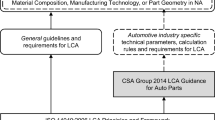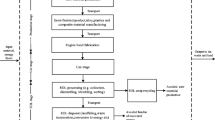Abstract
Background, aim, and scope
Policy initiatives, such as the EU End of Life Vehicle (ELV) Directive for only 5% landfilling by 2015, are increasing the pressure for higher material recyclability rates. This is stimulating research into material alternatives and end-of-life strategies for automotive components. This study presents a Life Cycle Assessment (LCA) on an Australian automotive component, namely an exterior door skin. The functional unit for this study is one door skin set (4 exterior skins). The material alternatives are steel, which is currently used by Australian manufacturers, aluminium and glass-fiber reinforced polypropylene composite. Only the inputs and outputs relative to the door skin production, use and end-of-life phases were considered within the system boundary. Landfill, energy recovery and mechanical recycling were the end-of-life phases considered. The aim of the study is to highlight the most environmentally attractive material and end-of-life option.
Methods
The LCA was performed according to the ISO 14040 standard series. All information considered in this study (use of fossil and non fossil based energy resources, water, chemicals etc.) were taken up in in-depth data. The data for the production, use and end-of-life phases of the door skin set was based upon softwares such as SimaPro and GEMIS which helped in the development of the inventory for the different end-of-life scenarios. In other cases, the inventory was developed using derivations obtained from published journals. Some data was obtained from GM-Holden and the Co-operative research Centre for Advanced Automotive Technology (AutoCRC), in Australia. In cases where data from the Australian economy was unavailable, such as the data relating to energy recovery methods, a generic data set based on European recycling companies was employed. The characterization factors used for normalization of data were taken from (Saling et. al. Int J Life Cycle Assess 7(4):203–218 2002) which detailed the method of carrying out an LCA.
Results
The production phase results in maximum raw material consumption for all materials, and it is higher for metals than for the composite. Energy consumption is greatest in the use phase, with maximum consumption for steel. Aluminium consumes most energy in the production phase. Global Warming Potential (GWP) also follows a trend similar to that of energy consumption. Photo Oxidants Creation Potential (POCP) is the highest for the landfill scenario for the composite, followed by steel and aluminium. Acidification Potential (AP) is the highest for all the end-of-life scenarios of the composite. Ozone Depletion Potential (ODP) is the highest for the metals. The net water emissions are also higher for composite in comparison to metals despite high pollution in the production phases of metallic door skins. Solid wastes are higher for the metallic door skins.
Discussion
The composite door skin has the lowest energy consumption in the production phase, due to the low energy requirements during the manufacturing of E-glass and its fusion with polypropylene to form sheet molding compounds. In general, the air emissions during the use phase are strongly dependent on the mass of the skins, with higher emissions for the metals than for the composite. Material recovery through recycling is the highest in metals due to efficient separation techniques, while mechanical recycling is the most efficient for the composite. The heavy steel skins produce the maximum solid wastes primarily due to higher fuel consumption. Water pollution reduction benefit is highest in case of metals, again due to the high efficiency of magnetic separation technique in the case of steel and eddy current separation technique in the case of aluminium. Material recovery in these metals reduces the amount of water needed to produce a new door skin set (water employed mainly in the ingot casting stage). Moreover, the use of heavy metals, inorganic salts and other chemicals is minimized by efficient material recovery.
Conclusions
The use of the studied type of steel for the door skins is a poor environmental option in every impact category. Aluminium and composite materials should be considered to develop a more sustainable and energy efficient automobile. In particular, this LCA study shows that glass-fiber composite skins with mechanical recycling or energy recovery method could be environmentally desirable, compared to aluminium and steel skins. However, the current limit on the efficiency of recycling is the prime barrier to increasing the sustainability of composite skins.
Recommendations and perspectives
The study is successful in developing a detailed LCA for the three different types of door skin materials and their respective recycling or end-of-life scenarios. The results obtained could be used for future work on an eco-efficiency portfolio for the entire car. However, there is a need for a detailed assessment of toxicity and risk potentials arising from each of the four different types of door skin sets. This will require greater communication between academia and the automotive industry to improve the quality of the LCA data. Sensitivity analysis needs to be performed such as the assessment of the impact of varying substitution factors on the life cycle of a door skin. Incorporation of door skin sets made of new biomaterials need to be accounted for as another functional unit in future LCA studies.









Similar content being viewed by others
References
Barbero E (1998) Introduction to composite materials design. Materials Science and Engineering Series, 1st edn. Taylor & Francis
Directive 2000/53/EC of the European Parliament and of the Council
Environmental impact of end-of-life vehicles (2002) An information paper ‘Environment Australia’
Global emission model for integrated systems (GEMIS) Version 4.3 (Taken from http://www.oeko.de/service/gemis/en/index.htm)
Hendrix J, Massey K, Whitham E, Bras B (1996) Technologies for the identification, separation and recycling of automotive plastics. Int J Environmentally Conscious Design and Manufacturing 5
Hill S (1996) Reincarnation—recycling in the automotive industry. Materials World 4(10):5576
ISO 14040: Environmental management—Life cycle assessment—Principles and framework
Fussler C (1999) Die Oeko Innovation. S. Hirzel Verlag Stuttgart, p127
Makuta M, Moriguchi Y, Yasuda Y, Sueno S (2000) Evaluation of the effect of automotive bumper recycling by life cycle inventory analysis. J Materials Cycles Waste Manage 12:125–137
Munoz I, Rieradevall J, Domenech X, Gazulla C (2006) Using LCA to assess eco-design in the automotive sector (Case Study of a Polyolefinic Door Panel). Int J Life Cycle Assess 11(5):323–334
Poulakis J, Varelidis P, Papaspyrides C (1997) Recycling of polypropylene based composites. Advances in Polymer Technol 16(4):313–322
Rydh C, Sun M (2005) Life cycle inventory data for materials grouped according to environmental and material properties. J Cleaner Prod 13:1258–1268
Saling P, Kicherer A, Dittrich B, Wittlinger R, Zombik W, Schmidt I, Schrott W, Schmidt S (2002) Eco-efficiency analysis by BASF: The Method. Int J Life Cycle Assess 7(4):203–218
Schmidt W-P, Dahlqvist E, Finkbeiner M, Krinke S, Lazzari OD, Pichon S, Thiel C (2004) Life cycle assessment of lightweight and end-of-life scenarios for generic compact class passenger vehicles. Int J Life Cycle Assess 9(6):405–416
SimaPro7 demo (taken from http://www.pre.nl/simapro/default.htm)
Acknowledgements
The authors are grateful to AutoCRC, Melbourne and the Department of Engineering, Australian National University for the financial support for the study. The authors thank the officials at GM Holden for providing the Holden specific data relating to the mass of door skins currently being used in Holden cars.
Author information
Authors and Affiliations
Corresponding author
Additional information
Discussion contributions to this article from the readership would the highly welcome. The authors
Rights and permissions
About this article
Cite this article
Puri, P., Compston, P. & Pantano, V. Life cycle assessment of Australian automotive door skins. Int J Life Cycle Assess 14, 420–428 (2009). https://doi.org/10.1007/s11367-009-0103-7
Received:
Accepted:
Published:
Issue Date:
DOI: https://doi.org/10.1007/s11367-009-0103-7




